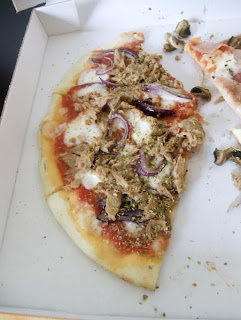Today we went to the overly prestigious Porche Museum designed by Delugan Meissl. Truly a heavenly experience as describe by the tour guide. As we ascended into the “heaven’s”, it was obvious why this design of the building was chosen, it reflects the car company; flashy, showy and expensive. A beautiful building nonetheless, I am reminded what someone said to me, “this building would probably fall down easily in an earthquake”. This building reflects on of the age old question in architecture, should a building give up its aesthetics for its function, or in this case the structure integrity of the building. After all there was a lot of wasted space in the building, but it looked good, and if you have the money and dreams then go for it.
The second car museum we saw was the Mercedes-Benz Museum. Although not a direct opposite of the museum, the architecture reflected the car company; innovation and engineering. The museum felt more like a science center than a car museum, different from the Porche Museum which just had cars on display, the Mercedes Benz Museum had interactive exhibits, similar to the BMW Welt, with its key feature being a simulated tornado that can be formed through the core space that broke the Guinness Book of World Records for the strongest artificially created tornado in the world. The building was a trefoil spiral that started at the top that wound its way down towards the bottom with the exhibit following in chronological order from the use of horse travel to the newest innovations in alternative energy. The building was over all very impressive and is  still requiring me to wrap my head around the circulation and structure of the building. After this, we had a short lunch at a pizza place where one person had to cook 10 pizzas in 20 minutes, which to my surprise, she did. Unfornutaley I got wrapped up in the confusion and chaos and ordered a tuna pizza. I would not recommend this as a topping.We went to the Weissenhof, a modernist development in Stuttgart with houses designed by Mies van der Rohe, LeCorbusier and Walter Gropius. Similar to the Bauhaus, the buildings were plain and simple yet elegantly beautiful. These were interesting houses that are classics of modern architecture exhibiting LeCorubusier 5 Pillars of Architecture; a pilotis system, open floor plan, free façade, horizontal windows and rooftop garden. The development was a futuristic look at what a neighborhood could be like with housing built according to modernist architecture. The neighborhood had a bit of charm to it, from what I remember and the place was quite nice. The proportions of the buildings were to scale of the human figure and the views out over the city were beautiful. This was the first building I had seen by LeCorbusier with his rooftop gardens, part of his idea of the 5 pillars of architecture
still requiring me to wrap my head around the circulation and structure of the building. After this, we had a short lunch at a pizza place where one person had to cook 10 pizzas in 20 minutes, which to my surprise, she did. Unfornutaley I got wrapped up in the confusion and chaos and ordered a tuna pizza. I would not recommend this as a topping.We went to the Weissenhof, a modernist development in Stuttgart with houses designed by Mies van der Rohe, LeCorbusier and Walter Gropius. Similar to the Bauhaus, the buildings were plain and simple yet elegantly beautiful. These were interesting houses that are classics of modern architecture exhibiting LeCorubusier 5 Pillars of Architecture; a pilotis system, open floor plan, free façade, horizontal windows and rooftop garden. The development was a futuristic look at what a neighborhood could be like with housing built according to modernist architecture. The neighborhood had a bit of charm to it, from what I remember and the place was quite nice. The proportions of the buildings were to scale of the human figure and the views out over the city were beautiful. This was the first building I had seen by LeCorbusier with his rooftop gardens, part of his idea of the 5 pillars of architecture
The day winded down with a drive-by of the extremely post modern Statsgallerie by James Sterling. This building was like a Roman ruin with Lego bricks added to it. We then headed back to the hotel.














